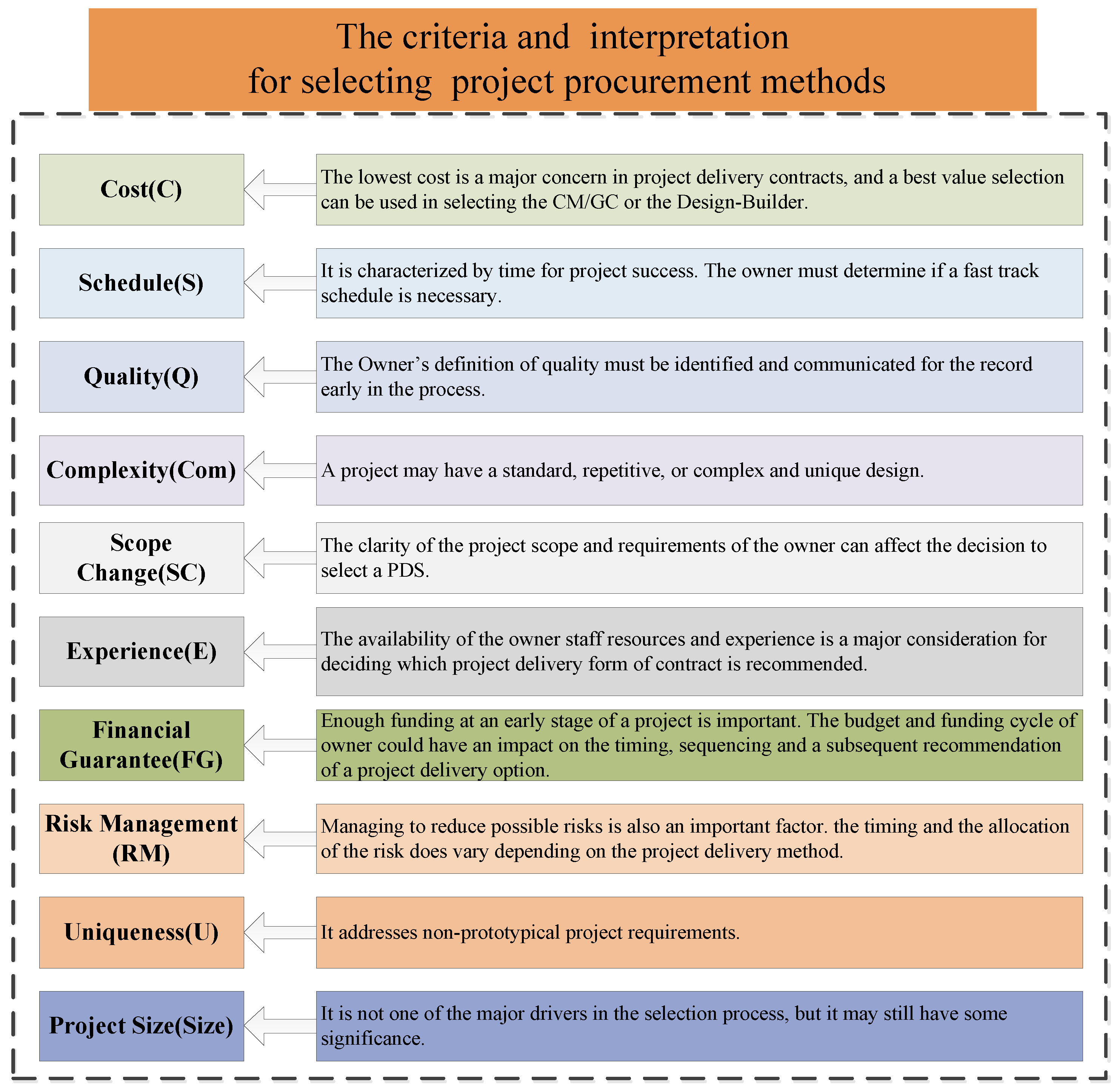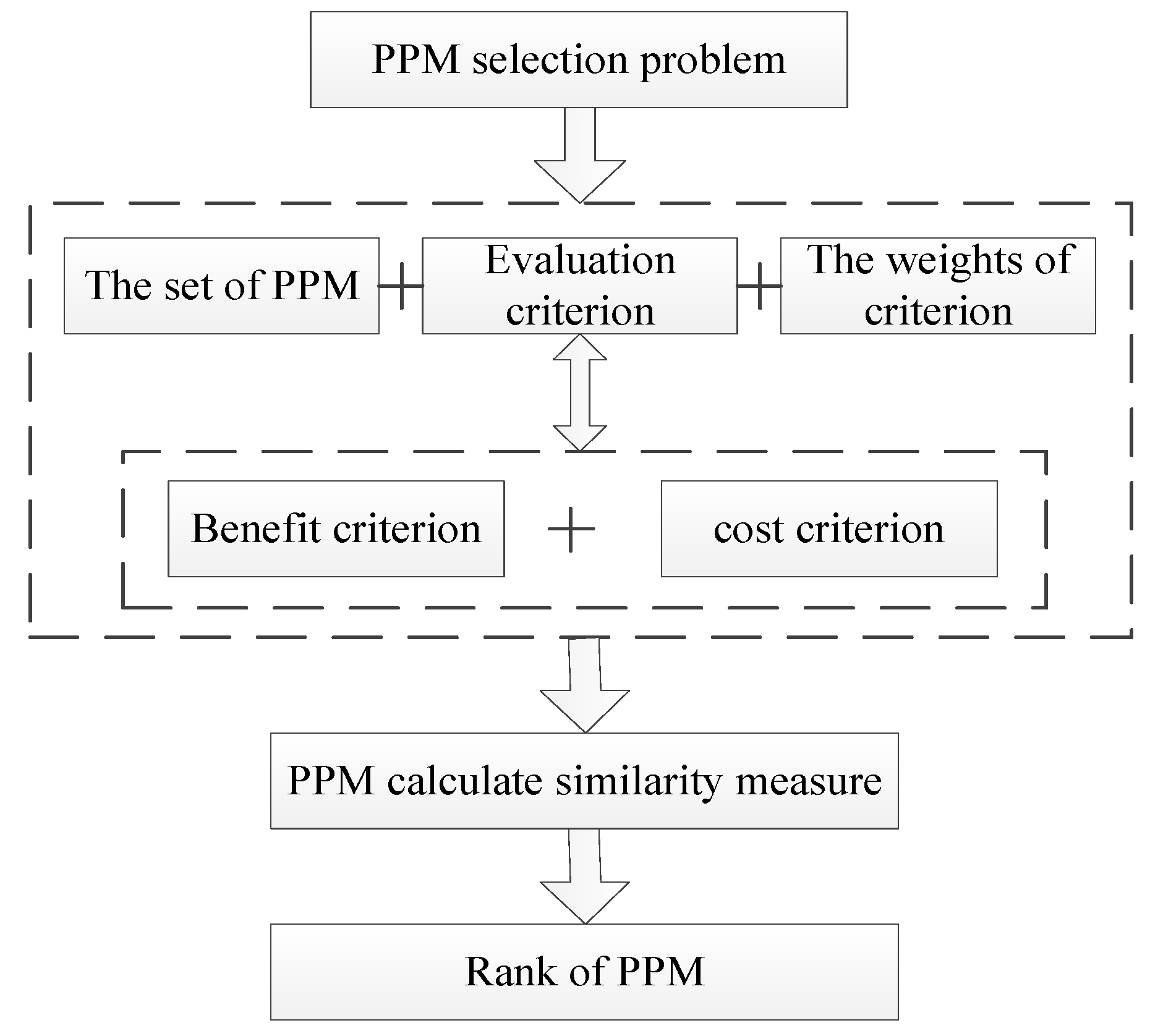Project Procurement Method Selection Using a Multi-Criteria Decision-Making Method with Interval Neutrosophic Sets
Abstract
:1. Introduction
2. Decision-Making Framework for PPM Selection
3. Methodology for the PPM Selection
3.1. Preliminaries
- (a)
- If and , then is greater than , that is, ;
- (b)
- If , then is quasi-greater than , that is, .
3.2. Similarity Measures Between INSs Based on Minimum and Maximum Operators
- (1)
- ;
- (2)
- if;
- (3)
- ;
- (4)
- andiffor INS.
- (1)
- ;
- (2)
- if;
- (3)
- ;
- (4)
- andiffor INS, where, , andare the weights of the three independent elements (i.e., the truth, indeterminacy, and falsity memberships) in an INS and.
- (1)
- ;
- (2)
- if;
- (3)
- ;
- (4)
- andiffor INS.
4. Decision-Making Model for PPM Selection Based on Similarity Measures
4.1. Description of Decision-Making for PPM Selection
4.2. Steps for Selection of PPM Using the Proposed Method
- Step 1:
- Decision matrices determined.
- Step 2:
- Ideal alternative PPM identified, using Equations (5) and (6).
- Step 3:
- Evaluation matrix and ideal alternative PPM were transformed into other representations, using Equation (1).
- Step 4:
- The weights of the criteria were calculated.
- Step 5:
- The measures of similarity between the ideal alternative PPM and each alternative PPM were calculated, using the proposed similarity measures.
- Step 6:
- The alternative PPMs were ranked in accordance with the results obtained in Step 5.
5. Practical Example
- Step 1:
- The evaluation matrix , was constructed, where , , , and were the evaluation information for the four PPMs, and
- Step 2:
- The ideal alternative PPM was determined, using Equations (8) and (9):
- Step 3:
- The raw evaluation data matrix and the ideal alternative PPM were transformed, using Equation (1).
- Step 4:
- The similarity measures between the ideal PPM and each alternative PPM were calculated, using Equation (4) with and .
6. Comparative Analysis
7. Conclusions
Author Contributions
Funding
Conflicts of Interest
References
- Oyetunji, A.A.; Anderson, S.D. Relative effectiveness of project delivery and contract strategies. J. Constr. Eng. Manag. 2006, 132, 3–13. [Google Scholar] [CrossRef]
- Yakowenko, G. Megaproject procurement: Breaking from tradition. Public Roads 2004, 68, 48–53. [Google Scholar]
- Goldberg, V.P. Readings in the Economics of Contract Law: Transaction Cost Determinants of “Unfair” Contractual Arrangements; Cambridge University Press: Cambridge, UK, 1982; pp. 139–146. [Google Scholar]
- An, X.W.; Wang, Z.F.; Li, H.M.; Ding, J.Y. Project Delivery System Selection with Interval-Valued Intuitionistic Fuzzy Set Group Decision-Making Method. Group Decis. Negot. 2018, 27, 689–707. [Google Scholar] [CrossRef]
- Ding, J.Y.; Jia, J.Y.; Jin, C.H.; Wang, N. An Innovative Method for Project Transaction Mode Design Based on Case-Based Reasoning: A Chinese Case Study. Sustainability 2018, 10, 4127. [Google Scholar] [CrossRef]
- Song, J.B.; Zhang, H.L.; Dong, W.L. A review of emerging trends in global PPP research: Analysis and visualization. Scientometrics 2016, 107, 1111–1147. [Google Scholar] [CrossRef]
- Osei-Kyei, R.; Chan, A.P.C. Review of studies on the Critical Success Factors for Public-Private Partnership (PPP) projects from 1990 to 2013. Int. J. Proj. Manag. 2015, 33, 1335–1346. [Google Scholar] [CrossRef]
- Alhazmi, T.; Mccaffer, R. Project Procurement System Selection Model. J. Constr. Eng. Manag. 2000, 126, 176–184. [Google Scholar] [CrossRef]
- Luo, S.Z.; Cheng, P.F.; Wang, J.Q.; Huang, Y.J. Selecting Project Delivery Systems Based on Simplified Neutrosophic Linguistic Preference Relations. Symmetry 2017, 9, 151. [Google Scholar] [CrossRef]
- Gordon, C.M. Choosing appropriate construction contracting method. J. Constr. Eng. Manag. 1994, 120, 196–210. [Google Scholar] [CrossRef]
- Li, H.M.; Qin, K.L.; Li, P. Selection of project delivery approach with unascertained model. Kybernetes 2015, 44, 238–252. [Google Scholar] [CrossRef]
- Mahdi, I.M.; Alreshaid, K. Decision support system for selecting the proper project delivery method using analytical hierarchy process (AHP). Int. J. Proj. Manag. 2005, 23, 564–572. [Google Scholar] [CrossRef]
- Ng, S.T.; Luu, D.T.; Chen, S.E.; Lam, K.C. Fuzzy membership functions of procurement selection criteria. Constr. Manag. Econ. 2002, 20, 285–296. [Google Scholar] [CrossRef]
- Chan, C.T.W. Fuzzy procurement selection model for construction projects. Constr. Manag. Econ. 2007, 25, 611–618. [Google Scholar] [CrossRef]
- Li, H.; Cao, Y.; Su, L.; Xia, Q. An Interval Pythagorean Fuzzy Multi-criteria Decision Making Method Based on Similarity Measures and Connection Numbers. Information 2019, 10, 80. [Google Scholar] [CrossRef]
- Mafakheri, F.; Dai, L.; Slezak, D.; Nasiri, F. Project delivery system selection under uncertainty: Multicriteria multilevel decision aid model. J. Manag. Eng. 2007, 23, 200–206. [Google Scholar] [CrossRef]
- Atanassov, K.T. Intuitionistic fuzzy sets. Fuzzy Sets Syst. 1986, 20, 87–96. [Google Scholar] [CrossRef]
- Stanujkić, D.; Karabašević, D. An extension of the WASPAS method for decision-making problems with intuitionistic fuzzy numbers: A case of website evaluation. Oper. Res. Eng. Sci. Theory Appl. 2018, 1, 29–39. [Google Scholar] [CrossRef]
- Yager, R.R. Pythagorean membership grades in multi-criteria decision making. IEEE Trans. Fuzzy Syst. 2014, 22, 958–965. [Google Scholar] [CrossRef]
- Smarandache, F. A unifying field in logics: Neutrosophic logic. Mult.-Valued Log. 1999, 8, 489–503. [Google Scholar]
- Wang, H.; Smarandache, F.; Zhang, Y.Q.; Sunderraman, R. Single valued neutrosophic sets. Multispace Multistructure 2010, 4, 410–413. [Google Scholar]
- Wang, H.; Smarandache, F.; Zhang, Y.Q.; Sunderraman, R. Interval neutrosophic sets and logic: Theory and applications in computing. Comput. Sci. 2005, 65, 87. [Google Scholar]
- Peng, X.D. New multiparametric similarity measure and distance measure for interval neutrosophic set with IOT industry evaluation. IEEE Access 2019, 7, 28258–28280. [Google Scholar] [CrossRef]
- Sahin, R. Cross-entropy measure on interval neutrosophic sets and its applications in multicriteria decision making. Neural Comput. Appl. 2017, 28, 1177–1187. [Google Scholar] [CrossRef]
- Liu, F.; Aiwu, G.; Lukovac, V.; Vukic, M. A multi-criteria model for the selection of the transport service provider: A single valued neutrosophic DEMATEL multi-criteria model. Decis. Mak. Appl. Manag. Eng. 2018, 1, 121–131. [Google Scholar] [CrossRef]
- Mondal, K.; Pramanik, S.; Giri, B.C. Interval Neutrosophic Tangent Similarity Measure Based MADM strategy and its Application to MADM Problems. Neutrosophic Sets Syst. 2018, 19, 47–56. [Google Scholar]
- Ye, J. A multi-criteria decision making method using aggregating operators for simplified neutrosophic sets. J. Intell. Fuzzy Syst. 2014, 26, 2459–2466. [Google Scholar]
- Su, L.; He, H.; Lu, H. Multi-criteria decision making method with interval neutrosophic setting based on minimum and maximum operators. Int. J. Circuits Syst. Signal Process. 2019, 13, 177–182. [Google Scholar]
- Sengupta, A.; Pal, T.K. On comparing interval numbers. Eur. J. Oper. Res. 2000, 127, 28–43. [Google Scholar] [CrossRef]
- Chen, D.; Zhang, F. The Supplement and Improvement of an Interval-numbers Algorithm. J. Liaocheng Univ. 2009, 22, 20–21. (In Chinese) [Google Scholar]
- Wang, H.; Smarandache, F.; Zhang, Y.Q.; Sunderraman, R. Interval Neutrosophic Sets and Logic: Theory and Applications in Computing; Georgia State University: Atlanta, GA, USA, 2005. [Google Scholar]
- Pourghasemi, H.R.; Pradhan, B.; Gokceoglu, C. Application of fuzzy logic and analytical hierarchy process (AHP) to landslide susceptibility mapping at Haraz watershed, Iran. Nat. Hazards 2012, 63, 965–996. [Google Scholar] [CrossRef]
- Rezaei, J. Best-worst multi-criteria decision-making method. Omega 2015, 53, 49–57. [Google Scholar] [CrossRef]
- Shannon, C.E.; Weaver, W. The Mathematical Theory of Communication; The University of Illinois Press: Urbana, IL, USA, 1947. [Google Scholar]
- Pamučar, D.; Stević, Ž.; Sremac, S. A new model for determining weight coefficients of criteria in MCDM models: Full consistency method (FUCOM). Symmetry 2018, 10, 393. [Google Scholar] [CrossRef]
- Stojić, G.; Stević, Ž.; Antuchevičienė, J.; Pamučar, D.; Vasiljević, M. A novel rough WASPAS approach for supplier selection in a company manufacturing PVC carpentry products. Information 2018, 9, 121. [Google Scholar] [CrossRef]
- Behzadian, M.; Khanmohammadi Otaghsara, S.; Yazdani, M.; Ignatius, J. A state-of the-art survey of TOPSIS applications. Expert Syst. Appl. 2012, 39, 13051–13069. [Google Scholar] [CrossRef]
- Chi, P.P.; Liu, P.D. An extended TOPSIS method for multiple attribute decision making problems based on interval neutrosophic set. Neutrosophic Sets Syst. 2013, 1, 1–8. [Google Scholar]
- Ye, J. Similarity measures between interval neutrosophic sets and their applications in multicriteria decision-making. J. Intell. Fuzzy Syst. 2014, 26, 165–172. [Google Scholar]
- Ye, J.; Du, S. Some distances, similarity and entropy measures for interval-valued neutrosophic sets and their relationship. Int. J. Mach. Learn. Cybern. 2019, 10, 347–355. [Google Scholar] [CrossRef]



| PPMs | Classical TOPSIS | Proposed Method | ||
|---|---|---|---|---|
| Results | Rank | Results | Rank | |
| DB | 0.4770 | 3 | 2 | |
| DBB | 0.5340 | 2 | 3 | |
| CM | 0.3729 | 4 | 4 | |
| EPC | 0.6112 | 1 | 1 | |
© 2019 by the authors. Licensee MDPI, Basel, Switzerland. This article is an open access article distributed under the terms and conditions of the Creative Commons Attribution (CC BY) license (http://creativecommons.org/licenses/by/4.0/).
Share and Cite
Su, L.; Wang, T.; Wang, L.; Li, H.; Cao, Y. Project Procurement Method Selection Using a Multi-Criteria Decision-Making Method with Interval Neutrosophic Sets. Information 2019, 10, 201. https://doi.org/10.3390/info10060201
Su L, Wang T, Wang L, Li H, Cao Y. Project Procurement Method Selection Using a Multi-Criteria Decision-Making Method with Interval Neutrosophic Sets. Information. 2019; 10(6):201. https://doi.org/10.3390/info10060201
Chicago/Turabian StyleSu, Limin, Tianze Wang, Lunyan Wang, Huimin Li, and Yongchao Cao. 2019. "Project Procurement Method Selection Using a Multi-Criteria Decision-Making Method with Interval Neutrosophic Sets" Information 10, no. 6: 201. https://doi.org/10.3390/info10060201
APA StyleSu, L., Wang, T., Wang, L., Li, H., & Cao, Y. (2019). Project Procurement Method Selection Using a Multi-Criteria Decision-Making Method with Interval Neutrosophic Sets. Information, 10(6), 201. https://doi.org/10.3390/info10060201






